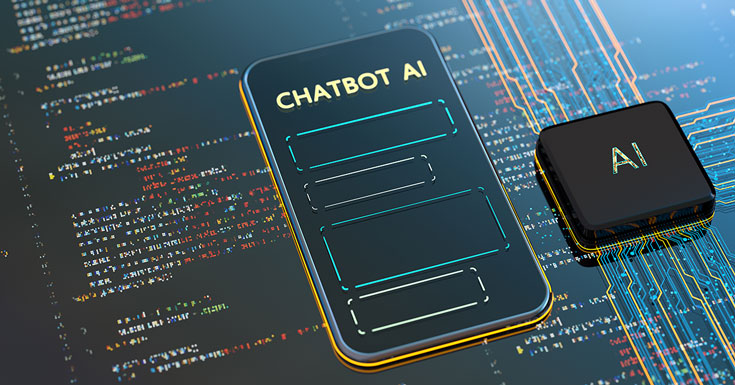7 FAQs About AI Chatbots for Colleges and Universities
Former Analyst

When it comes to AI chatbots, colleges and universities generally fall into one of two categories: those that already have a chatbot but might not be leveraging the solution’s full capabilities, and those that are exploring the possibility of implementing a chatbot to experiment with AI, especially generative AI.
With the rapidly evolving AI chatbot market, many higher education institutions in both scenarios are left with questions. Let’s explore answers to seven common questions Tambellini Group analysts have received from higher education institutions.
Should I Build My Own AI Chatbot or Use an Out-of-the-Box Solution?
The answer to this question is highly dependent on the institution. Colleges and universities should understand their current and future institutional needs, chatbot goals, available resources and budget (remember to factor in long-term staffing and maintenance costs!), timeline, data considerations, and more when determining whether to build their own chatbot or leverage an out-of-the-box solution.
Some large enterprises outside of higher education have chosen to develop their own custom generative AI solutions. This approach might be viable for institutions that have sufficient in-house DevOps, engineering staff, and hardware resources to train and manage their own fine-tuned large language models (LLMs). By owning the LLM, an institution can keep its data in-house, fully customize the solution, and develop it using open-source software. However, it’s often unclear whether the substantial investment required for fine-tuning a customized LLM is justified.
The middle ground is a general-purpose AI communications platform that allows for some customization but does not require the machine learning expertise to fine-tune an LLM. General-purpose chatbots can typically be deployed institution-wide, helping address various use cases and needs depending on how they are implemented. AWS, Google, IBM, Microsoft, and OpenAI are common providers of custom chatbots.
However, general-purpose chatbots may not be the right option for every institution. Due to their highly customizable nature, general-purpose chatbots are best suited for institutions that want—and have the resources—to be hands-on in developing and managing a custom AI chatbot solution.
There are also a number of AI chatbot solutions available for institutions that can be quickly deployed out-of-the-box. Some AI chatbots can address a variety of institutional needs, while others are focused on a particular use case, such as recruitment or student success. Many of these solutions offer opportunities for customization, but not at the same level as a general-purpose chatbot solution. All in all, building vs. buying an AI chatbot solution will depend upon many factors specific to the institution’s goals and capabilities.
For more details about general-purpose chatbots, Tambellini Group clients can access our latest research, 2024 Comparison of General-Purpose AI Chatbots infographic and the 2024 Practice Guide: Selecting and Managing AI Chatbots, in the client portal.
How Do You Get Started with AI Chatbots When You’re a Resource-Constrained College/University?
Colleges or universities with limited budgets who still want to experiment with or get started with AI chatbots have options. We recommend starting small. Consider a pilot chatbot project to address a specific use case or need. Many solution providers offer free trials, which are a great way to test the solution and your use case without a financial commitment. When possible, choosing a pay-per-chat pricing model can be more economical than a flat fee per user depending on the general usage.
We also recommend evaluating your current communications channels. Prioritize channels you know students prefer, such as mobile apps, texting, and online chat. Do not be afraid to decommission a channel if students are not active on it. As resources tighten, focus your time and effort on the most effective channels.
As with any technology investment, it’s crucial for your team to develop a strategy that documents your institution’s needs, goals, and expectations and aligns these with your available resources. Doing so will ensure you evaluate and select the best AI chatbot for your institution, which can save time and money in the long run.
How Do I Ensure a Seamless Integration with My Existing College/University Technology Systems?
First, take inventory of all existing and future software systems to identify those that will need to be integrated with the chatbot platform. Determining whether a chatbot solution integrates with your existing systems should be part of your evaluation criteria for an AI chatbot solution, along with current and future use cases, functionality, cost, scope, usability, support, and the product’s future roadmap. Many products on the market offer integrations with popular customer relationship management systems (CRMs), learning management systems, student systems, and more, supporting more personalized communications. Some products also offer an API that allows customers to develop their chatbot to be integrated within the systems they need.
What Data Should Colleges/Universities Use to Train Their AI Chatbot?
In the rare cases of institutions fine-tuning a custom LLM, they should use clean text data that is representative of the tone and general writing style they would like their chatbot to utilize. The data needs to be diverse, without bias, and as close as possible to the ideal performance of the chatbot.
Although most institutions won’t be training or fine-tuning their own LLMs, it’s still crucial to leverage data insights from AI chatbots to improve performance and inform communication strategies. Analysis techniques can include reviewing trends across the chat conversations for common questions and observing when and how students interact with the chatbot.
How Can Admissions Offices Use AI Chatbots to Interact with Prospective Students?
Chatbots that can answer common prospective student questions have been available for years. Now, more recent advanced AI chatbot functionality can schedule campus visits, provide self-guided campus tours, help streamline the initial application process, and track a prospect’s application status. Some chatbot solutions specialize in onboarding support, providing step-by-step guidance through enrollment, housing, orientation, and other new-student processes. Others support the institution’s prospect pipeline by extracting lead data from conversations with the bot, which can be utilized to personalize communication in future campaigns, leading to increased applications and enrollment. Download our recent infographic, The Role of AI Chatbots in Higher Education, to view solution providers in this category and more. Tambellini clients can access an expanded version of the infographic in the Peertelligent® client portal.
How are College and University Operations and Administrative Teams Using AI Chatbots?
We’re seeing increasing adoption of admin-only question-and-answer bots that can answer common questions about payroll, human resources, and other administrative topics 24/7. This is helping save administrative and operational staff time, while enhancing employee satisfaction by gaining quick answers to their employee-related questions.
We’re also seeing institutions use chatbots at IT helpdesks to troubleshoot common technical problems for students, faculty, and staff, such as password resets. Some initial reports from institutions show that these chatbots help decrease calls to the helpdesk and increase ticket resolution rates. Many administrative chatbots can escalate questions and route users to a human who can help with more hands-on support.
How Can You Manage Fears Around AI Adoption and Job Loss?
Fears around AI replacing jobs are still very prevalent, and managing those fears involves change management—an important aspect of any technology initiative.
When looking at implementing an AI chatbot, consider who may be impacted and communicate early and often. Depending on the culture at your institution, you may hold a team or department meeting, a town hall meeting, or another forum where stakeholders can ask questions and express concerns for you to address. For more specific change management guidance, read our blog post, “Tips for Getting Started with Change Management in Higher Education.”
Users often have concerns about how their data is handled. If AI is implemented irresponsibly, their data might be used in ways they are unaware of, do not approve of, or both. To responsibly implement AI, institutions must establish and share a unified AI policy that details how users’ data will be used and protected. This should be accompanied by enforcing ethical AI practices and secure data controls.
For more details about data management and AI policy, Tambellini Group clients can access our latest research, Navigating the Journey to Data Management Excellence in Higher Education infographic and Navigating AI in Higher Education: A Comparative Analysis of Institutional Policies white paper in the client portal.
When it comes to fears of job loss, most institutions view AI chatbots as a means to augment and automate more manual, error-prone, or time-consuming tasks, supporting employees rather than replacing them. Currently, most higher education employees have varying responsibilities and while advancing rapidly, current chatbots in the market cannot fully replace these roles. Other industries that are seeing AI replace some positions are those that are very niche and typically focused on one task. Clearly communicating these viewpoints during the previously suggested forums to concerned constituents can go a long way to alleviate fears about AI.
The AI chatbot landscape is constantly evolving. Stay up to date on the latest trends with Tambellini research, resources, and events. Want to talk about how to implement or optimize a chatbot solution on your campus? Contact us to discuss your options today!
You May Also Like:
Categories
Share Article:

Other Posts From this Author:
© Copyright 2025, The Tambellini Group. All Rights Reserved.